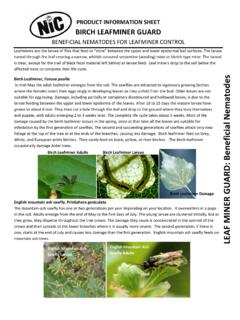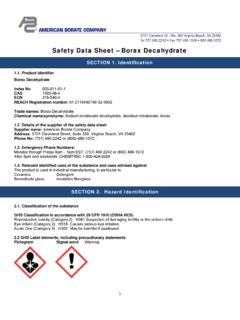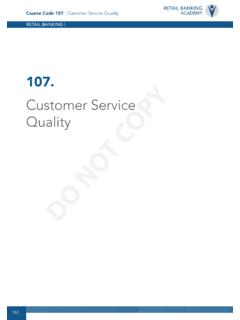Transcription of CTP Plate Cleaner - GSB Chemicals
1 GSB Chemical Hazard Alert Code: 2 CTP Plate CleanerChemwatch: 5888156 Version No: Data Sheet according to WHS and ADG requirementsIssue Date: 09/04/2014 Print Date: 10/11/2015 Initial Date: Not 1 IDENTIFICATION OF THE SUBSTANCE / MIXTURE AND OF THE COMPANY / UNDERTAKINGP roduct IdentifierProduct nameCTP Plate CleanerSynonymsPlate rejuvenator, Product Code: H361 Proper shipping nameENVIRONMENTALLY HAZARDOUS SUBSTANCE, LIQUID, (contains naphtha petroleum, light aromatic solvent and gum turpentine)Other means ofidentificationNot AvailableRelevant identified uses of the substance or mixture and uses advised againstRelevant identified usesCleaning of lithographic printing plates prior to storage. Applied via a cloth direct from the of the supplier of the safety data sheetRegistered company nameGSB Chemical Camp Road Broadmeadows 3047 VIC AustraliaTelephone+61 3 9457 1125 (8am-5pm, Monday - Friday)Fax+61 3 9459 7978 WebsiteNot telephone numberAssociation / OrganisationNot AvailableEmergency telephonenumbers+61 3 9457 1125 (8am-5pm, Monday - Friday)Other emergency telephonenumbers13 11 26 (After hours)SECTION 2 HAZARDS IDENTIFICATIONC lassification of the substance or mixtureHAZARDOUS CHEMICAL.
2 DANGEROUS GOODS. According to the Model WHS Regulations and the ADG ScheduleS5 GHS Classification [1]Acute Toxicity (Oral) Category 4, Acute Toxicity (Dermal) Category 4, Acute Toxicity (Inhalation) Category 4, Skin Corrosion/Irritation Category 2, Eye IrritationCategory 2A, Skin Sensitizer Category 1, STOT - SE (Resp. Irr.) Category 3, STOT - SE (Narcosis) Category 3, Aspiration Hazard Category 1, AcuteAquatic Hazard Category 2, Chronic Aquatic Hazard Category 2 Legend:1. Classified by Chemwatch; 2. Classification drawn from HSIS ; 3. Classification drawn from EC Directive 1272/2008 - Annex VILabel elementsGHS label elementsSIGNAL WORDDANGERH azard statement(s)H302 Harmful if swallowedH312 Harmful in contact with skinH332 Harmful if inhaledH315 Causes skin irritationH319 Causes serious eye irritationH317 May cause an allergic skin reactionH335 May cause respiratory irritationH336 May cause drowsiness or be fatal if swallowed and enters airwaysH401 Toxic to aquatic lifeH411 Toxic to aquatic life with long lasting effectsPrecautionary statement(s) PreventionP271 Use only outdoors or in a well-ventilated protective gloves/protective clothing/eye protection/face breathing dust/fume/gas/mist/ not eat, drink or smoke when using this release to the work clothing should not be allowed out of the statement(s) ResponseP301+P310IF SWALLOWED.
3 Immediately call a POISON CENTER or NOT induce off contaminated clothing and wash before contaminated clothing before +P352IF ON SKIN: Wash with plenty of soap and +P351+P338IF IN EYES: Rinse cautiously with water for several minutes. Remove contact lenses, if present and easy to do. Continue +P313If skin irritation or rash occurs: Get medical +P313If eye irritation persists: Get medical +P312IF SWALLOWED: Call a POISON CENTER or doctor/physician if you feel +P340IF INHALED: Remove victim to fresh air and keep at rest in a position comfortable for statement(s) StorageP405 Store locked +P233 Store in a well-ventilated place. Keep container tightly statement(s) DisposalP501 Dispose of contents/container in accordance with local 3 COMPOSITION / INFORMATION ON INGREDIENTSS ubstancesSee section below for composition of MixturesMixturesCAS No%[weight] <107732-18-530-60 SECTION 4 FIRST AID MEASURESD escription of first aid measuresEye ContactIf this product comes in contact with the eyes: Wash out immediately with fresh running water.
4 Ensure complete irrigation of the eye by keeping eyelids apart and away from eye and moving the eyelids by occasionally lifting the upper and lower lids. Seek medical attention without delay; if pain persists or recurs seek medical attention. Removal of contact lenses after an eye injury should only be undertaken by skilled personnel. Skin ContactIf skin contact occurs:Immediately remove all contaminated clothing, including footwear. Flush skin and hair with running water (and soap if available). Seek medical attention in event of irritation. InhalationIf fumes or combustion products are inhaled remove from contaminated area. Lay patient down. Keep warm and rested. Prostheses such as false teeth, which may block airway, should be removed, where possible, prior to initiating first aid procedures. Apply artificial respiration if not breathing, preferably with a demand valve resuscitator, bag-valve mask device, or pocket mask as trained.
5 Perform CPR ifnecessary. Transport to hospital, or doctor, without delay. naphtha petroleum, light aromatic solventgum turpentinephosphoric acidwaterChemwatch: 5888156 Version No: 2 of 12 CTP Plate CleanerIssue Date: 09/04/2014 Print Date: 10/11 swallowed do NOT induce vomiting. If vomiting occurs, lean patient forward or place on left side (head-down position, if possible) to maintain open airway and prevent aspiration. Observe the patient carefully. Never give liquid to a person showing signs of being sleepy or with reduced awareness; becoming unconscious. Give water to rinse out mouth, then provide liquid slowly and as much as casualty can comfortably drink. Seek medical advice. Avoid giving milk or oils. Avoid giving alcohol. Indication of any immediate medical attention and special treatment neededFor acute or short term repeated exposures to petroleum distillates or related hydrocarbons: Primary threat to life, from pure petroleum distillate ingestion and/or inhalation, is respiratory failure.
6 Patients should be quickly evaluated for signs of respiratory distress ( cyanosis, tachypnoea, intercostal retraction, obtundation) and given oxygen. Patients with inadequate tidal volumes orpoor arterial blood gases (pO2 50 mm Hg) should be intubated. Arrhythmias complicate some hydrocarbon ingestion and/or inhalation and electrocardiographic evidence of myocardial injury has been reported; intravenous lines and cardiac monitors shouldbe established in obviously symptomatic patients. The lungs excrete inhaled solvents, so that hyperventilation improves clearance. A chest x-ray should be taken immediately after stabilisation of breathing and circulation to document aspiration and detect the presence of pneumothorax. Epinephrine (adrenalin) is not recommended for treatment of bronchospasm because of potential myocardial sensitisation to catecholamines.
7 Inhaled cardioselective bronchodilators ( , Salbutamol) are the preferred agents, with aminophylline a second choice. Lavage is indicated in patients who require decontamination; ensure use of cuffed endotracheal tube in adult patients. [Ellenhorn and Barceloux: Medical Toxicology] Any material aspirated during vomiting may produce lung injury. Therefore emesis should not be induced mechanically or pharmacologically. Mechanical means should be used if it is considerednecessary to evacuate the stomach contents; these include gastric lavage after endotracheal intubation. If spontaneous vomiting has occurred after ingestion, the patient should be monitored fordifficult breathing, as adverse effects of aspiration into the lungs may be delayed up to 48 phosphate salts intoxication:All treatments should be based on observed signs and symptoms of distress in the patient.
8 Consideration should be given to the possibility that overexposure to materials other than this productmay have of large quantities of phosphate salts (over grams for an adult) may cause an osmotic catharsis resulting in diarrhoea and probable abdominal cramps. Larger doses such as 4-8grams will almost certainly cause these effects in everyone. In healthy individuals most of the ingested salt will be excreted in the faeces with the diarrhoea and, thus, not cause any systemictoxicity. Doses greater than 10 grams hypothetically may cause systemic should take into consideration both anionic and cation portion of the molecule. All phosphate salts, except calcium salts, have a hypothetical risk of hypocalcaemia, so calcium levels should be monitored. Treat 5 FIREFIGHTING MEASURESE xtinguishing mediaThe product contains a substantial proportion of water, therefore there are no restrictions on the type of extinguishing media which may be used.
9 Choice of extinguishing media should take intoaccount surrounding the material is non-combustible, evaporation of water from the mixture, caused by the heat of nearby fire, may produce floating layers of combustible such an event consider:foam. dry chemical powder. carbon dioxide. Special hazards arising from the substrate or mixtureFire IncompatibilityAvoid contamination with oxidising agents nitrates, oxidising acids, chlorine bleaches, pool chlorine etc. as ignition may result Advice for firefightersFire FightingAlert Fire Brigade and tell them location and nature of hazard. Wear full body protective clothing with breathing apparatus. Prevent, by any means available, spillage from entering drains or water course. Use water delivered as a fine spray to control fire and cool adjacent area. Avoid spraying water onto liquid pools. DO NOT approach containers suspected to be hot.
10 Cool fire exposed containers with water spray from a protected location. If safe to do so, remove containers from path of fire. Fire/Explosion HazardCombustible. Slight fire hazard when exposed to heat or flame. Heating may cause expansion or decomposition leading to violent rupture of containers. On combustion, may emit toxic fumes of carbon monoxide (CO). May emit acrid smoke. Mists containing combustible materials may be explosive. Combustion products include:, carbon dioxide (CO2), phosphorus oxides (POx), other pyrolysis products typical of burning organic material CARE: Water incontact with hot liquid may cause foaming and a steam explosion with wide scattering of hot oil and possible severe burns. Foaming may cause overflow ofcontainers and may result in possible 6 ACCIDENTAL RELEASE MEASURESP ersonal precautions, protective equipment and emergency proceduresMinor SpillsEnvironmental hazard - contain spillage.






